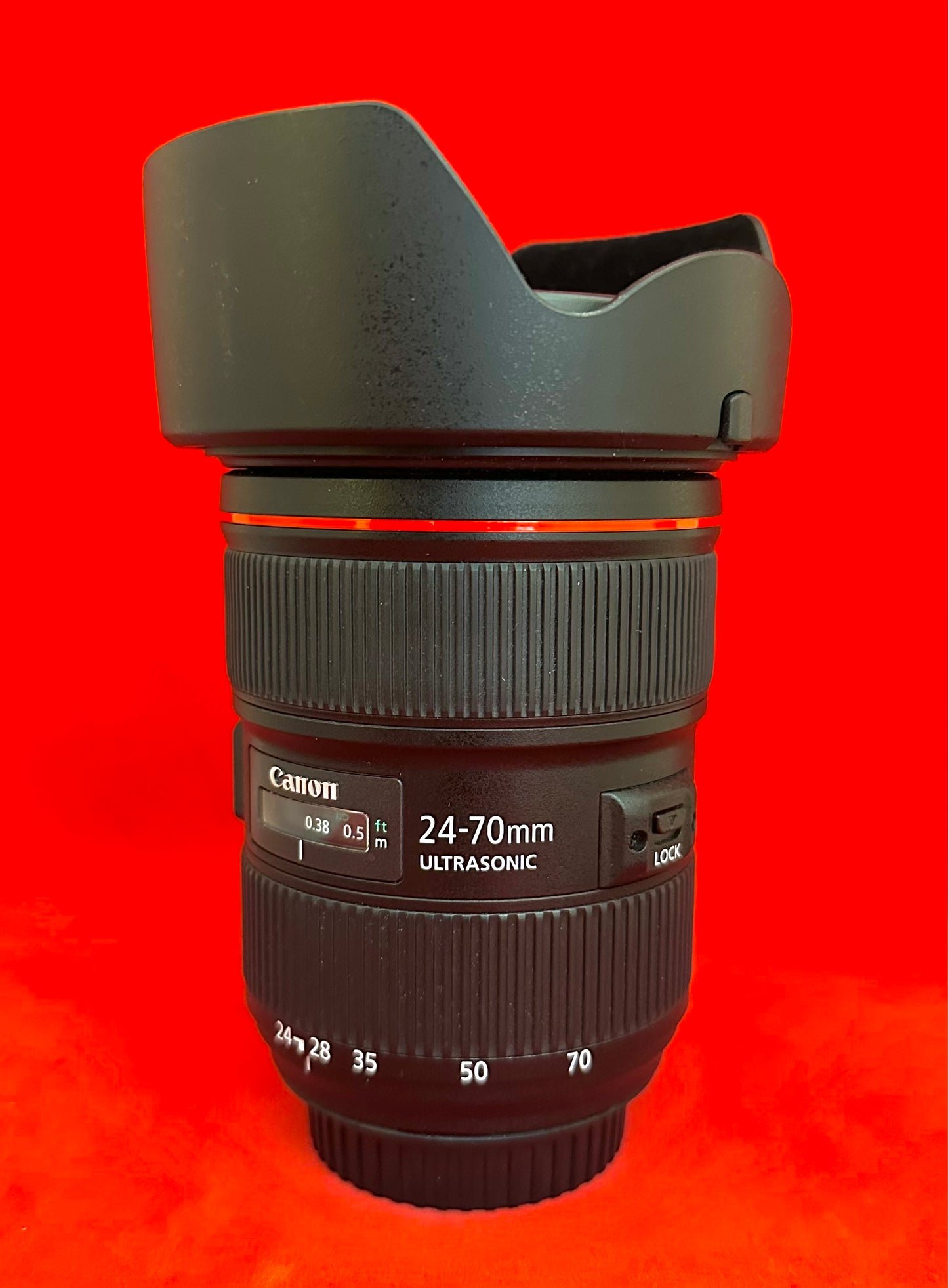Luck Tech Cameras
Canon EF 24-70mm f/2.8 L II USM Lens (used)
Canon EF 24-70mm f/2.8 L II USM Lens (used)
Couldn't load pickup availability
Available At:
Canon EF 24-70mm f/2.8 L II USM Lens
Condition: Used only few time, in excellent condition,the picture listed is the actual lens
Warranty: 6 months
Included: Canon lens 24-70mm f2.8 II, Front and back cover.
Description


The professional’s standard zoom lens
The EF 24-70mm f/2.8L II USM delivers superb image quality throughout its zoom range and is perfect for applications ranging from landscape and travel photography to portraiture and photojournalism.

Shoot in low light conditions
A fast f/2.8 maximum aperture is maintained throughout the zoom range, enabling hand-held low-light shooting in a variety of situations.

USM autofocus
A ring-type ultrasonic AF motor achieves focus quickly, quietly and accurately. Full-time manual override is available, making it possible to adjust focus without changing focus modes.

Beautiful background blur
A 9-bladed circular aperture provides superb bokeh, ideal for portraiture.
The 24-70mm focal length is one of the most popular for serious enthusiasts and professional photographers. The EF24-70mm f/2.8L II USM zoom lens takes the performance of the previous model to the next level, offering the best image quality available in a lens of this zoom range. Centred on the standard focal length of 50mm, it offers a zoom range from wide-angle to short telephoto, making it ideal for shooting everything from landscapes to portraits in one lens.
Favoured by photojournalists, wedding photographers and portrait shooters, the 24-70mm zoom focal range gives versatility in use and a fast, constant f/2.8 maximum aperture, allowing you to continue shooting in low light situations. With redesigned optics, it offers even higher image quality than its predecessor.
- High-speed USM AF
- Fluorine lens coating front and rear
- 9-blade circular aperture
- Three Aspheric lens elements
- One Super Ultra-low Dispersion lens element
- Two Ultra-low Dispersion (UD) lens elements
- Minimum focusing distance: 0.38m at all focal lengths
- Improved dust and weather resistance
- Improved durability for daily use
- Front of lens doesn’t rotate during focusing
- Manual focus possible in AF mode
- Only lead-free glass is used
- Filter Size: 82mm
The constant f/2.8 maximum aperture throughout the zoom range means that you always have optimum control over depth-of-field. It also makes the lens a great low light performer that’s able to make the most of what ambient light may be available before you need to resort to using flash.
The close focusing distance of just 38cm throughout the zoom range allows you to get in near to your subject to add impact, or to take a step back to include more of the surroundings.
Compared to the EF24-70mm f/2.8L USM lens it replaces, the new zoom lens is shorter by 10mm, and is almost 150g lighter, so it takes up less space in the bag and is easier to carry. It has been made even more durable and weather-sealed to cope with everyday use in harsh environments in the hands of professional photographers.
The lens’ optical design is completely new compared to the outgoing model. It includes three aspherical lens elements, two of which are Glass Mold (GMo) and one is ground glass. These are combined with a two Ultra-low Dispersion (UD) elements and a single Super-UD element to provide the highest possible image quality in a lens of this focal length.
The new 9-bladed diaphragm (compared to 8-blades in the previous model) produces a circular aperture for pleasing out of focus highlights and attractive bokeh. This helps your subject stand out against the background with no distractions.
To ensure sharp, in-focus images, the lens is fitted with a ring-type USM autofocus motor for fast, silent focusing at all times. The addition of full-time manual focusing allows you to adjust focus manually without first having to switch to MF.
USM Autofocus:
A ring-type USM autofocus motor means that you can focus quickly, near-silently and with precision. It also provides full-time manual focus so that you can adjust the focus with the focus ring, without first having to switch the lens to manual focus. This allows you to adjust the focus accurately to ensure it is exactly where you want it to be for the most creative control possible.
Distance Information:
For use with E-TTL II flash metering, this lens provides distance information back to any EOS DSLR camera body to help to refine the flash metering algorithms and ensure accurate flash exposure.
Super Spectra Coatings:
The Super Spectra coating achieves two benefits – it cuts down internal flare and ghosting when light reflects off the digital sensor providing images with improved contrast. The coatings are optimized for each lens design, so it also ensures accurate colour balance across the entire EF lens range so that all lenses have a uniform colour response.
Share










